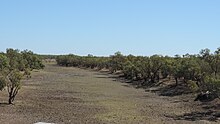Nymphaea georginae is a species of waterlily native to the Northern Territory, and the state of Queensland, Australia.[2]
Description
Vegetative characteristics
Nymphaea georginae is a perennial plant with 4 cm wide, globose rhizomes. The orbicular to elliptic, 60 cm wide floating leaves have dentate margins.[3]
Generative characteristics
The fragrant flowers can extend up to 30 cm above the water surface. The flowers have 4 sepals, and 12-26 petals. The androecium consists of 150-250 stamens. The gynoecium consists of 7-19 carpels. The 4 cm wide, globose fruit bears globose to subglobose, 2.5-4 mm wide seeds with interrupted rows of 0.1-0.15 mm long trichomes. The flowers are the most fragrant flowers within Nymphaea subgenus Anecphya.[3]
Taxonomy
Publication
It was first described by Surrey Wilfrid Laurance Jacobs and Carl Barre Hellquist in 2006.[2]
Type specimen
The type specimen of Nymphaea georginae was collected by S. Jacobs and C. B. Hellquist in the Georgina River in Camooweal, Queensland, Australia on the 19th April 2005.[3][4]
Placement within Nymphaea
It is placed in Nymphaea subgenus Anecphya.[3]
Etymology
The specific epithet georginae refers to the Georgina River, which is the type locality.[3]
Conservation
The NCA status of Nymphaea georginae is Special Least Concern (SL).[1]
Ecology

Habitat
Nymphaea georginae grows in billabongs and flood channels, habitats characterised by prolonged periods of drought and equally extended wet periods.[3]
References
- ^ a b Queensland Government. (2022d, March 8). Species profile — Nymphaea georginae. Retrieved December 30, 2023, from https://apps.des.qld.gov.au/species-search/details/?id=30918
- ^ a b c d "Nymphaea georginae S.W.L.Jacobs & Hellq". Plants of the World Online. Royal Botanic Gardens, Kew. Retrieved 30 December 2023.
- ^ a b c d e f Jacobs, S. W., & Hellquist, C. B. (2006). "Three new species of Nymphaea (Nymphaeaceae) in Australia." Telopea, 11(2), 155-160.
- ^ Holotype of Nymphaea georginae S.W.L.Jacobs & Hellq. [family NYMPHAEACEAE]. (n.d.). JSTOR. Retrieved December 30, 2023, from https://plants.jstor.org/stable/10.5555/al.ap.specimen.nsw921918









You must be logged in to post a comment.